No, I’m not in Vietnam. And if I was, I wouldn’t want to be there for a lifetime. But I did make a trip there some twenty-one years ago, and so twenty-one years ago, I wrote an article called “A Lifetime in Vietnam.” That was roughly at the time blogging began, but I wasn’t an early blogger. Rather, I sent out stories to an e-mail subscription list. Sort of the same result, but different methodology.
When I wrote a short while ago about the early internet and the beginnings of the web, I thought about the Vietnam trip, and decided it needed re-telling – this time to a wider audience.
I went to Hanoi at the invitation of computer company, which wanted to know more about this emerging Internet thingy. It was an expenses paid trip, so I thought “why not?” I figured I would experience a lot, and in fact I called the story “A Lifetime in…” because I felt I’d gained a lifetime’s worth of experiences in just a few days.
Below, is what I wrote twenty-one years ago, with just a few edits to aid readability. It was written mostly for a western audience, and I should warn you – it’s long. I should know, I’ve just finished re-typing it; my only original copy being a rather faded PDF file from an ancient scanner. You might want to grab a coffee and donut before you start.
Since then, the world has changed in more ways than we can remember. For instance, to access the internet, I had to use a dial-up modem, and make an international call to Malaysia.
Don’t forget 1994 was only nineteen years after the end of the Vietnam War. There were very few tourists, and even fewer white or whitish looking people like me. That’s partly what makes this story different. Today, Hanoi would be on the normal tourist beat, but not then…
December 1994
Introduction
It took several months of planning to make this short visit to Vietnam, and it had been delayed a number of times for various reasons. Until only a couple of days before my actual departure date, I was still not sure if it was going to happen. But, on Saturday Dec. 10th. I received a fax confirming arrangements and advising the location of the hotel (a nice thing to have!) and so at 11am Monday 12th. I boarded a non-stop Malaysia Airlines flight bound for Hanoi.
Although the trip was for business purposes, it was impossible to concentrate my attentions solely on this aspect – in fact, on occasions it was difficult to concentrate at all with so many unusual affairs taking place around me. I was so bombarded with new experiences that each evening during the trip I spent some considerable time making notes, in the hope the experiences would be easier to recall once I had a chance to put pinkies to plastic and begin typing this story.
Getting There
For once I checked in early enough to enjoy a choice of seats, and sensibly chose a window seat. My principal reason was to catch up on some sleep – the few days prior to my departure having been rather hectic. Window seats allow you to rest your head against the side of the fuselage, and also ensure you are not disturbed constantly by a fellow passenger with a weak bladder. But this was no occasion to sleep, because the views – under a clear blue sky for the whole trip – were simply superb.
Leaving Subang International Airport on-time, we flew directly North along the line of the West Coast of Peninsular Malaysia. (By “we” I mean myself and and the other airline passengers, since this was a trip I was making alone.) There were excellent views of the islands of Pangkor, the somewhat larger Penang – where the buildings of the capital Georgetown and the North Coast Resorts were clearly visible, followed – a little further in the distance – by Langkawi.
At this point, the thin strip of land stretching down from the main part of Thailand becomes quite narrow, and bends – somewhat banana shaped – towards the West. As a result, our Northbound flight crossed the Southern tip of Thailand, just North of the Malaysian border, leaving land at Songkhla and flying just a few kilometers from the East coast and across the Gulf of Thailand.
For the next thirty minutes or so, the views were not so interesting, but it was still possible to see long sandy beaches in the distance, and the clear blue of the Gulf below. MAS thoughtfully served a good lunch during this break. Landfall was made on the Southern coast of the main part of Thailand, and the scenery here was quite different than that of the isthmus to the West of us – which – at its Northern end is mostly part of Burma (Myanmar) rather than Thailand.
Initially, the land looked like miles and miles of deserted sand flats, which seemed to stretch a good two kilometers or so inland. But very quickly it became densely inhabited, and within minutes we were flying directly over Bangkok. Even from 35,000ft, it was easy to see why the traffic is so chaotic – there was only one major highway in sight, and I believe even that one had not yet opened. There were a couple of others which seemed to be under construction, and which just stopped dead when meeting one of the many rivers. I guess bridges cost more, and so these will be constructed sometime – maybe this century, maybe not.
It was easy to see too why the mighty Choa Phraya river is considered a good alternative to road transportation. It runs North-South, right through the heart of the city, and has many navigable tributaries and joining canals. North of Bangkok the land was flat and very arid. It looked like there had been no rain in many months. There were small communities bordering the muddy rivers, and small patches of green where there was maybe some means of irrigation, but despite this, most parts of the land were divided into fields of all shapes and sizes, and, I assumed at some times of the year cultivation was possible. For the most part it looked like central France at the end of a very hot dry summer.
Round about here, I wondered if we were lost. Hanoi is NNE of KL, but we were still travelling due North. I had expected the flight to cross either Southern Vietnam or Cambodia, but crossing the latter perhaps is not permitted, and maybe prevailing winds determine which way around Cambodia you should travel on any particular day. Eventually though, some distance North of Bangkok, we made one of only two course changes in the whole trip, and turned about 20 degrees East.
Almost immediately the scenery changed. Mountains appeared, and the land became greener. The color of the rivers changed from the usual muddy brown to various shades of blue and even deep green. As the terrain became more mountainous, trees and various kinds of vegetation were visible, and the whole landscape became mostly green, with some patches of bare limestone appearing. Soon the Mekong River came into sight, winding its way through the mountains, and marking the border between Thailand and Laos.
It also marked the end, for probably thirty minutes, of any sign of human activity. The mountains of Laos are high and constant, with few plateaus where farming could be carried out. In many of the valleys there were spectacular lakes of an azure blue, the color being created, I assume, by limestone particles carried down the mountainside in the thousands of streams which must run in the lengthy monsoon season.
Eventually the mountains started to recede, and it was at this time we made our second course change to put us onto a direct track into Hanoi, The diminishing mountains also marked the border with Vietnam, and within minutes they had almost disappeared. The land became a flat plateau, on which it was clear there was considerable cultivation. Small villages were visible, plus laterite roads that were such a bright red color, they looked like they’d been painted.
Approaching Hanoi the scenery changed little. There were no extra signs of habitation – just an occasional village – but it seemed like every spare piece of land had been divided into a manageable oblong, surrounded by water. Unlike Thailand, it looked like irrigation was well planned, and there was certainly no visible shortage of water.
As we made our final approach the midday sun was almost overhead, and the reflection in the channels parallel to our approach path looked very much like a searchlight seeking enemy aircraft. As the sun hit a pond between fields there was a blinding flash of light, and I could almost imagine the tracer bullets coming soon after. This was Vietnam don’t forget – the very word conjures-up all kinds of wild mental images.
All too soon we were on the ground after a fascinating flight, and were seeing the kind of sights I had expected. A well-used concrete runway, a few not-too-serviceable-looking fighter planes, totally unserviceable Russian-built passenger jets, most with a significant number of parts missing, old partly bombed-out airport buildings, and then eventually a terminal building which was probably built some thirty years ago and patched-up after the war. There were no “gates” at which the airplanes could be conveniently parked, but ancient Russian buses to ferry the passengers from the steps to the terminal. Luckily, this wasn’t the monsoon season, and the temperature was a very pleasant clear and sunny 26°C.
During the three hour flight, not only had I eaten a pleasant meal, but I’d also had time to fill out the many and various forms needed to clear Customs and Immigration. Obtaining the entry visa, neatly chopped on a full page of my passport, had already involved much paperwork, a fee of US$60, and a wait of ten days, so I was taken aback by the renewed attack on my writing skills. There were forms for entry, for exit, for baggage clearance, and for health clearance. On the latter, I had to declare I was not carrying any “body ashes.” Another first!
So, with much anticipation, I was off the aircraft, into the bus, and bumping my way towards the terminal building.
Airport To Hanoi
Walking the short distance from the airplane steps to the bus, and likewise from the bus to the terminal building, I realized how pleasantly warm the weather was. In Malaysia, 26°C would be rather chilly, but the sky was so clear the sun seamed to have an extra effect, and the humidity seemed to be surprisingly low. I quickly decided this would be a welcome change, and was certainly not what I’d expected. A number of sources told me at can be as low as 5°C in winter.
Arrival formalities were completed amazingly quickly – despite the number of forms to be processed. People actually seemed helpful, and appeared to be just going through the motions of living in a Communist country, rather than seriously inspecting everything. As I started to raise my luggage onto the inspection table the lady just laughed and asked for the yellow form – which she duly stamped without any kind of inspection. Before having even concluded these formalities a Vietnam Airlines representative had enquired whether I needed a taxi, and we had agreed the price. Once outside the terminal a mini bus was ready and waiting. He then chatted with the driver, and we agreed an extra US$3 to take the “motorway”; we shook hands, and the driver closed the door.
Then the real experience began.
The airport road led almost immediately onto this “motorway.” As an expressway, it was well constructed, but the way it was used was somewhat unusual. The central divider was made from stout concrete barriers, linked with solid-looking steel poles. The same method was used to protect the outside lanes from something which looked like a combined bicycle, motorcycle and bullock cart track, all of which was raised well above the level of the surrounding fields. Every mile or so there were gaps to allow any kind of traffic to cross the whole highway, which it frequently did – without any warning.
The system would have worked well had it not been for the fact many of the bicycle and motorbike riders chose to use the main carriageways – and by “use” I mean randomly travel on any part of the highway. I got the impression the vehicle with the right of way was the one moving the slowest. The taxi driver would beep his horn at anything that moved. All other vehicles with horns did the same thing. All of which produced a constant and annoying racket. But eventually I could see the necessity. Medium-speed motorbike riders would wander aimlessly into the fast lane without any thought of looking behind. Horn beeping was a substitute for rear view mirrors.
Everytime the taxi slowed to a crawl – forced to follow someone merrily pedalling along at his own speed – the horn blowing would increase to a fury until the culprit wandered back into the slow lane. This resulted in a small procession of horn-blowing drivers – a car at the back beeping a mini van beeping a flat-bed truck beeping a thirty year-old bus beeping an overloaded ancient truck beeping a bicycle rider carrying two weeks supply of vegetables in baskets strapped to the sides.
When I was brave enough to look in directions other than the chaos ahead of me, I could see cultivated plots of land stretching into the distance. There were of course endless rice padi fields, but in addition, a number of green vegetables, and fields of corn/maize.
People were working hard at all kinds of tasks, tending fields, building small homes and constructing roads all without any sign of mechanical assistance. No tractors, no diggers, not even a wheel barrow. Old ladies were humping huge rocks to the lay the foundation of a new farm track, and fields were filled with people laboring away while wearing their ubiquitous conical (dare I say comical?) hats so often seen in movies and photographs shot in Vietnam.
After maybe ten kilometers of the flat highway the dividers suddenly ended, and the road became an unprotected four-lane affair, rising, and turning suddenly and sharply to the left. This lead to a bridge over the Red River – which runs through Hanoi.
To the local drivers though, this meant an extra two lanes they could use. Suddenly there were vehicles everywhere. Sometimes we were speeding along in lanes I would have thought were reserved for oncoming traffic, and oncoming traffic was doing likewise. At this point it was impossible to know which side of the road you are supposed to drive on in Vietnam. Nominally, as an ex-French colony, it’s the right side.
Beyond the bridge there were a few more kilometers of semi-sanity on the bordered four-lane motorway, before, quite suddenly, we were plunged into the city streets of Hanoi. This occurred when the four lanes were blocked by stout concrete barriers, and the only road available was a narrow two-lane street filled with city traffic.
Ahead of us at the time was a very large truck looking more like a camouflaged Russian tank, and ahead of that, a bus. As we made the sharp left turn, the truck decided to pass the bus. This put the truck directly into the path of oncoming traffic on the two lane road, scattering cyclists in all directions. And then, a little late, he decided this was not such a good idea, and pulled sharply back into the correct lane – bring the bus to a screeching halt on the sidewalk. All of this allowed my taxi driver to pass both vehicles. No one one was killed. Or even injured.
Equally suddenly there were buildings everywhere – and almost all were tiny. Small thatched attap huts seemed to house whole families. Crudely-built brick and stone buildings, with individual frontages of no more than two meters, were being used for every kind of commerce imaginable. There were cafés, food stores, ironmongers, clothing retailers, and appliance stores all mixed-up together and doing business from this small frontage – with, inevitably, all their wares and activities spilling out onto the sidewalks. This made the narrow streets a dense mélange of pedestrians and cyclists, along with the motorized traffic, all trying to weave its way using either side of the road. The horn blowing rose to a crescendo, but it made no discernible difference.
Occasionally there were larger buildings, but these too occupied only a postage stamp sized piece of land, with maybe four or five storeys and just one room on each floor. They seemed like an unwise display of wealth in a communist country, but were perhaps symbols of a new prosperity and openness. The only conclusion I could reach for their bizzare shape was that land was extremely expensive.
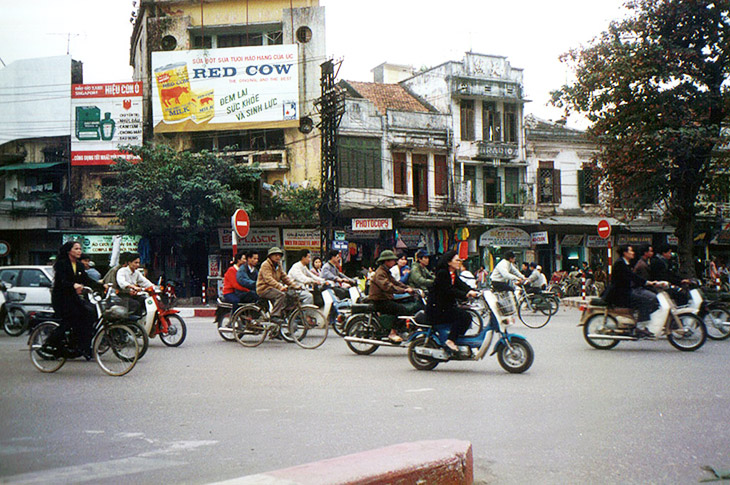
After ten minutes of meandering through the chaos, in which every moving object we passed or passed us, was within a few millimeters of being scraped, scratched or squished, the road opened out onto the local equivalent of Beijing’s Tiananmen Square. Here was the Ho Chi Minh mausoleum, where – between the hours of 8am and 10pm – one is allowed to view the revered gentleman’s body; an experience I’m grateful for missing,
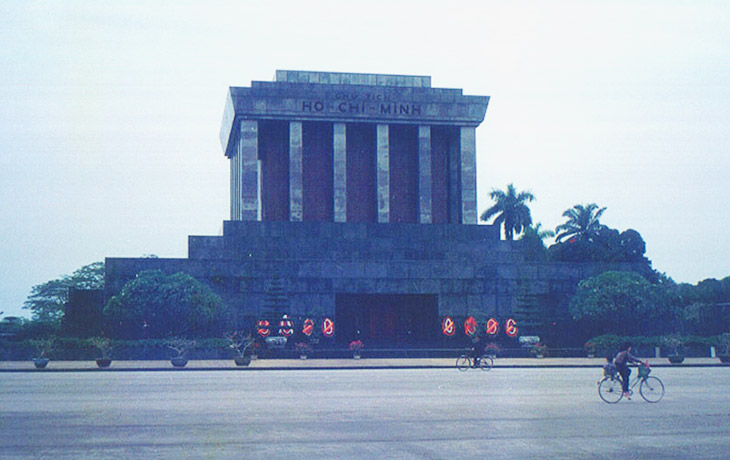
There are the inevitable parade grounds, and a huge Vietnamese flag with it’s gold star on a red background. The square seemed to mark the beginning of the real city, and the end of the residential area. From here, the streets were wide four-lane boulevards, bordered by colonial mansions or sturdier looking places of commerce. But; as far as I could see, nothing had been constructed in the last fifty years.
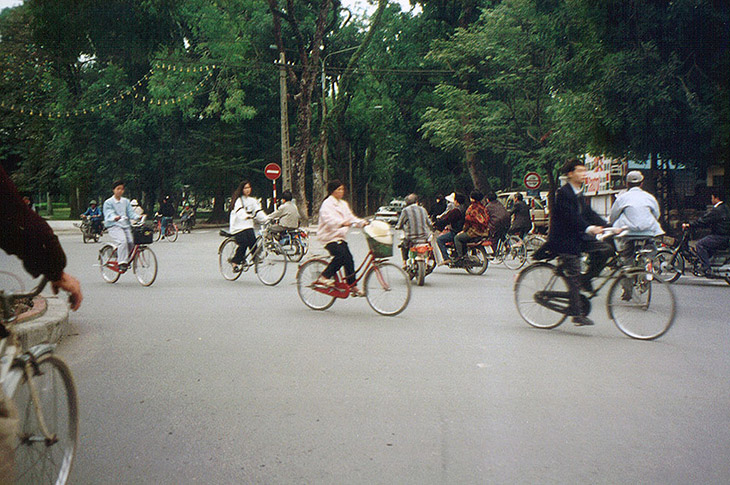
Of course, being a city, the traffic was still dense; still mostly two-wheeled vehicles, still with a number of pedestrians wandering in the road, and still with the large buses and trucks plus a few smaller four-wheeled vehicles trying to find a way through the moving river of humanity. At this point a couple of conclusions came to mind. Nothing moves fast enough for there to be a serious accident; and right of way seems to afforded to the person most likely to be injured if everyone continued on their intended course.
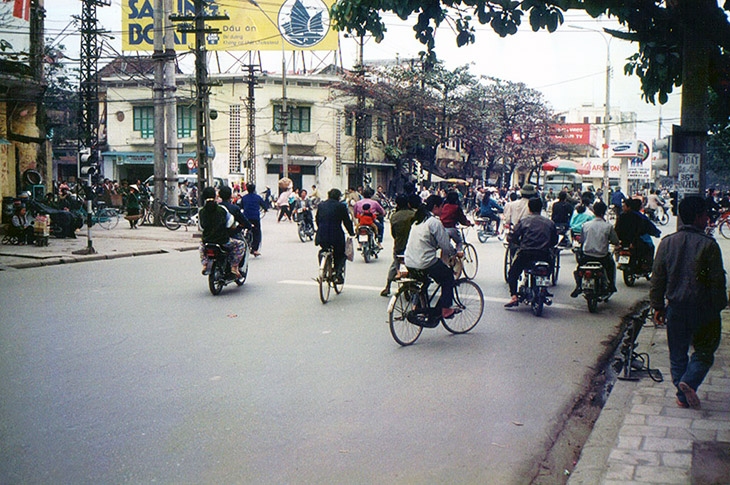
Another surprise came when we reached the first intersection of these four-lane city boulevards – no traffic lights. The only rules seemed to be – don’t look sideways, and don’t stop. Everyone seemed to have some kind of sixth sense to know whether a moving object seen from the corner of the eye should be allowed to pass in front, or whether it was possible to move fast enough to allow it to pass behind – and this whole process was, once again, a game of millimeters. I’ve often wondered how flock of thousands of migrating birds managed to avoid an occasional crash of wings, but by comparison with a Hanoi crossroads, this is just a matter of moving forwards at a constant speed. The crossroads though involved subtle speed changes and slight course changes, to ensure everything continues to move, uninterrupted.
First Port Of Call
Finally; after a journey from the airport which had lasted maybe forty minutes, I had arrived at my destination. Since I was visiting what I believed was the largest locally-owned computer company in Vietnam, I had expected some kind of office building. But, I was faced with a corner store type of operation, with a few personal computer-related items in the windows. Opening the narrow front door, and kind-of crashing through with baggage in tow, I was faced with a dozen pairs of staring eyes, which moments before had been looking at the other type of Windows, on their computer screens.
As my eyes adjusted, I could see there was a small reception area, so I duly presented myself, and almost had the impression I was expected. But, a mild panic came over the receptionist when she realized the person I was due to meet was not there.
“Would you mind taking a seat for a while?” she enquired. “No problem” I replied and sank into a rather small and low, but comfortable chair. The equally low table, I noticed, was filled with tiny tea cups and a small tea pot which had been used by previous visitors. With everything being about a quarter the size of normal I suddenly felt like I’d fallen through the same hole as Alice in Wonderland, and would soon be meeting with the Mad Hatter. Although I never did meet him, nothing that happened in the next few days served to dispel the illusion.
Within a minute a young lady arrived to serve tea – not unlike a Chinese-owned company, where the serving of tea is a ritual to be performed for any arriving visitor. What was unusual here though was my instant introduction to the recurring theme of a total lack of hygiene. A used cup was emptied into a china container designed for that purpose, and the cup instantly refilled with the fresh tea. I thanked her politely, but hoped I was not giving offense by ignoring the newly poured beverage in this pre-used miniature tea cup. When was it last washed I wondered. Had it ever been washed?
After a small wait, my colleague and counterpart Dr. Nam arrived, and greeted me like a long lost friend. This served to relieve a certain amount of tension, since up to this point I wasn’t 100% sure anyone had remembered I was coming. After meeting a few other folk it was suggested I check into my hotel – after which, we were scheduled to go to a different office where I was to prepare for my presentations. One of the young ladies in the office was directed to escort me the mere half block to the hotel; something, as I discovered later, is one way the Vietnamese extend courtesy to visitors, ensuring they are never alone when travelling around the city. This was much nicer than the used tea cups!
The hotel could have been in any central European city. It was small, old, but very clean. There seemed to be two sets of stairs, each of which lead to one room per floor. Those who took the front stairs had a room with a window – at the front of the hotel; those like me who took the back stairs, had a room at the back without a window. The lack of windows was the only thing I could have complained about. Well; that’s not quite true. The fact that all the windows in the corridors were heavily barred, and that there was no sign of any fire alarms or firefighting equipment, were causes for concern.
In the room there were two double-sized beds, a well stocked refrigerator, satellite TV, and a modern bathroom stocked with everything I could possibly need. My carefully-packed emergency supplies of anything you could think of, were clearly not going to be needed. So, after quickly unpacking, I was escorted the half block back to office #1.
Transportation
A young guy who had been using one of the PCs when I first walked in was asked to bring me office #2, where I was to setup some software for the following day’s presentation and discussion. Imagine my surprise when I discovered the means of transportation was one of the ubiquitous under-powered motorcycles. “Can we walk?” I asked politely. “No, too far” was the disappointing response. Now, I’m not too good with motorbikes. They strike me as suicidal machines. So you can imagine how I felt, dressed as smartly as six hours of travel would allow, carrying a briefcase, considering the traffic chaos, realizing that helmets would not be supplied – and then looking at the motorbike which had an A4-sized chromed metal plate where the extended seat would normally be. I assumed it was for carrying luggage, or a week’s supply of cabbages.
So, I nervously placed myself on the shiny plate putting my briefcase between us, and soon as the rider decided I must be ready, he accelerated smartly away – whereupon I plus briefcase slipped neatly off the back!
After a few more false starts it became obvious the only way to stay on the contraption was to bend forwards across my briefcase, and to grab the guy tightly around the waist. Eventually we were underway and wobbling crazily through the kind of traffic I’d hoped never to have negotiate without a few millimeters of reinforced steel around me.
As we came to our first crossroads I couldn’t figure whether I should just slide silently off the back and run like hell; shut my eyes and hope for the best, or just keep staring straight ahead like everyone else. I chose the latter, and through a blur of traffic I realized we were steadily and semi-safely reaching the end of the intersection. At the third junction a new scenario presented itself as we had to turn left. But this was handled with the same rules – wobble a little, but don’t stop.
Finally; the intended destination came into view, but horror of horrors, it was on the opposite side of the street, and coming at us were ten lanes of two, four, six and eight-wheeled traffic. But it was a case of stick to the rules, turn about thirty degrees to the left, and plow through the lot. The only good news was that I’d made a mental note of the route and that this experience was not going to be repeated. Shoes were going to take a beating but not the nerves.
Preparations
I was introduced to a few people who seemed quite mesmerized by the arrival of a white-ish foreigner – probably more white than usual after the ‘bike ride – who wanted to use one of their computers. Eventually I was shown to a PC – one in a long row of computers in a back corridor – and told I could setup my software here. I assumed the PC was to be moved to a conference room at some future point for the actual presentation.
The rest of the afternoon and early evening were spent loading software – with an audience of ten people – all eager to learn anything they could from the exercise. I had to try three or four modems of various makes and speeds, before finding one that would actually do something useful. I was assured they would find a faster one before the morning, and that for my presentation, everything would be just fine. On reflection, I was incredibly naïve to imagine I would be supplied with tested equipment and a calm and comfortable working environment.
Learning To Walk
By 6pm it was already dark, and I was feeling kind of pooped. No one had suggested any kind of activity for the evening, which made me feel mildly relieved. The next task therefore was to negotiate my way back to the hotel. Hoping not to offend, I declined the invitation of the ‘bike ride, but to my surprise the rider insisted he had to accompany me on my self-imposed trek. It made me wonder about the safety of the streets, but I hadn’t seen anything to make me feel concerned. So, we set off into the now darkened streets and back towards the first junction. I was quite convinced we should turn right, but my “guide” insisted we should go straight. Again, not wanting to give offense, I just shut-up and followed along.
At this point it hit me that walking was not quite the simple matter I had envisaged. If cross-roads have no traffic lights, the traffic never stops. So, there was no point just standing on the sidewalk waiting for everyone and everything to magically grind to a halt. The only solution was to remember the golden rules – look straight ahead, and don’t stop.
I figured that on foot, I was much more mobile, and far better able to move out of the path of an oncoming vehicle, than while perched precariously on the back of a motorcycle over which I had absolutely no control.
And guess what. The rules work.
But, after about half a block I could sense my companion was not sure if we were headed in the right direction, and with many apologies we retraced our steps. Back at the intersection I volunteered my opinion as to the direction from which I believed we had arrived. Whether deliberately or not I’ll never know, but we tried all the other directions before he stopped someone to ask for advice. At this point, and with many more apologies, he told me he wasn’t sure where we were because his eyesight was so poor. And I’d allowed myself to be transported on a motorcycle with him driving.
Finally though, we were back at the hotel. I offered to buy the beers but he declined, and within minutes I had returned to the peace and quiet of my own room. I wasn’t sure whether to laugh or cry, whether to crash onto the bed to relax, or hit the beers in he fridge. I picked the latter and a couple of beers later I was feeling moderately normal.
An Evening In France
After a shower and change, it was definitely time for some supper. I’d noticed a few tables in a small room behind the reception area, and assumed it would be possible to eat in. I wandered down to reception, glancing at the deserted tables on the way, and casually enquired when the restaurant would open. “Not open” came the response. “Yes, I noticed” I commented politely “but when will it open?” After a little chit-chat in Vietnamese, the two receptionists settled on “April 1st.” “Ahhh” I said in bemused surprise “I don’t think I’ll wait.” I’m not sure if the nervous giggles meant they understood my humor, or were just freaked out by the dumb foreigner.
In my afternoon travels I hadn’t seen any place I’d choose to eat in. Slow starvation seemed like a better choice than instant dysentry, so in some trepidation I asked if there were any restaurants around. “Oh yes, just around the corner there’s a bistro” they advised. Well; this was a better response than I’d expected, so off I set in the indicated direction.
By now the streets were much quieter, but a heavy haze had settled on the city – and with only a minimum of street lights, it wasn’t too easy to make my way to the next intersection. The sidewalks along the boulevards were very wide, but generally littered with all kinds of construction material. Almost every building seemed to be undergoing some kind of renovation, as the country was beginning a process of renewal in the expanding economy.
On this, my first walk without a “minder” in tow, I didn’t want to be too adventurous, and tried not to look too closely at the activities taking place around me. I could see though that most people were tucking into some kind of evening meal – either within their dimly lit homes – or sitting on miniature chairs alongside planks on bricks serving as tables, or were just squatting with their backs to the wall.
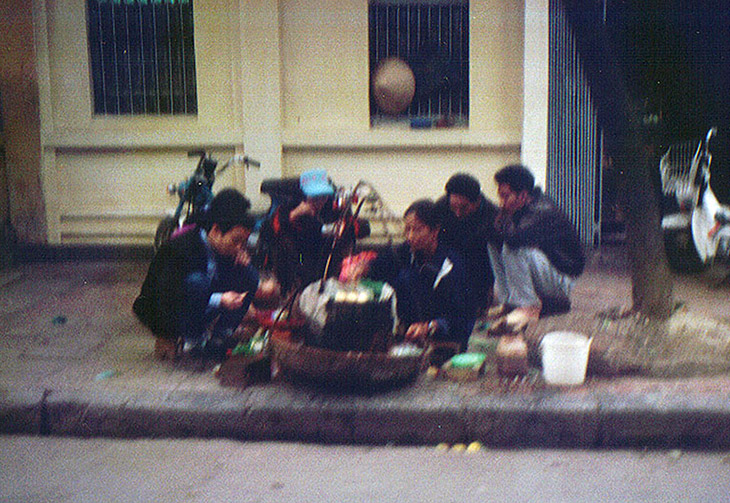
Signs of commercial activity had ended, and the city was preparing for an early night’s sleep. Once I’d reached the corner, I searched in vain for some kind of light which would indicate the location of said Bistro, but could see no more than a florescent glow from a building a further half block away. Luckily, this turned out to be “Le Bistro de Hanoi” – good name, I thought.
Walking through the door felt like an instant change of continents. Outside was the steamy darkness of semi-tropical Asia, inside could have been part of temperate Europe. The Bistro felt like it had been carefully transported straight out of central France – with all of its furnishings and fixtures intact. There were posters advertising the Moulin Rouge and Air France flights to “L’Indo Chine.” There was the blackboard with today’s “menu” chalked on it, the white paper “tablecloths” with red napkins, and even the obligatory opposing deer heads hanging on the walls. And of course it was smoke filled and had a wonderful smell of French cuisine.
Good signs were that it was quite busy, and that there was a number of locals merrily eating and drinking. I figured from this it must be a reasonably inexpensive place with good food. From a casually pointed finger from an overworked waitress I correctly assumed I was to sit at the corner table – an excellent location for watching the events of the evening. Quickly a menu appeared, and almost as quickly I realized I was in for a culinary treat, that is, if the meals tasted half as good as they sounded.
There was a choice of at least a hundred dishes, all French in origin, and any one of which would have kept my appetite well sated. The lack of prices on the menu gave me some cause for concern, and made me realize I would have to accept just about any amount that eventually appeared on the bill. But at that point, I was far too interested in getting stuck into the first french restaurant fare I had experienced in some years. A glass of wine was called for, received, and drunk, while making my food selection.
I chose charcuterie for starters. It consisted of a large plate of paté, deliciously coarse rillettes, some sliced sausage, and generous slices of a country ham – accompanied by another plate with a whole fresh hot loaf and butter. At the end of all this I was well and truly full, and not a morsel of this introduction to French-Vietnamese cuisine was left on either plate.
Then the main course arrived! Foie de veau. And of course, more wine.
I’m not sure why there were no vegetables with the main course – maybe they were extra – but I hadn’t seen them on the menu. So I was left with a whole plate of tender liver in a creamy onion sauce – with more bread. Delicious. Then came the bill – and my first introduction to Vietnamese currency.
The meal and wine cost a grand total of Dong117,000. I’d been told it was possible to conduct most transactions in US dollars, but unfortunately the waiter had an even poorer knowledge of conversion rates than I did. He tried to convince me this seemingly massive amount of money converted to the almost equally massive US$117. Okay, the supper was good, the wine was pleasant, whatever it was, but US$117 for one meal in a third-world country seemed ridiculous. Luckily, a few more people joined in on the act, which resulted in a zero being removed, and the waiter somewhat sheepishly settling for US$11. Suddenly the whole evening had become a bargain.
It’s easy to understand why US dollars are preferred. At about D10,000 to US$1, and with the largest denomination bill being D50,000 you can easily end-up with huge piles of cash to carry around. There are no coins, and the smallest bill I saw was D2000 – worth about US20cents. The temptation was always there to change US$100 in order to become an instant millionaire – but I resisted, and eventually changed US$60 – which, as it turned out, was very difficult to get rid of.
On my short walk back to the hotel I moved much slower. Partly weighed down with food, partly due to the relaxing effect of the wine, but partly also in having more confidence – having survived the walk to the restaurant. I peered carefully into the buildings as I passed. Most rooms, in which whole families were finishing their evening meals, had one bare dim light bulb. The rooms, it appeared, doubled as places of business, and beds, tables, and chairs were surrounded by bicycles, boxes of goods for sale, cooking facilities, and all manner of rubbish. This, clearly, was a country in which 99% of the population lived in almost total poverty. With a per capita income of US$20 a month, and an inflation rate rapidly rising into two figures, it seems it’s going to take some strict economic policies to prevent a national disaster.
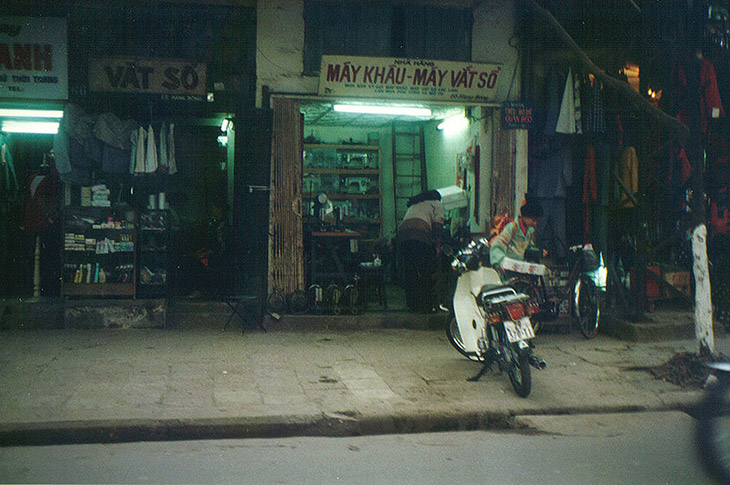
Poverty is nothing new in Southeast Asia, but in most countries I’ve seen, it’s only a minority of the population that’s affected. I’ve seen people living in wooden packing crates within sight of the office towers and opulence of Manila – but never witnessed a whole population in the same state. Could this be a benefit or blight of the communist system I wondered, as I re-entered the brightness of my hotel.
The Story Of Day Two
My second day dawned with heavily overcast skies and cooler temperatures. A jacket was a necessity.
I was pleased to discover the small restaurant in the hotel was at least open for breakfast, and that I neither had to wait until April 1st., nor try to negotiate a bowl of rice porridge from a street vendor.
Language is a challenge in Vietnam. Most people seem to speak English, but with an unintelligble accent. Which means they also don’t understand mine. Ordering breakfast was a challenge. Despite the fact the waiter kept insisting I had to have two eggs, I kept insisting I wanted something else. Eventually I decided to settle for whatever he wanted to bring, and just hoped it would include some bread and jam, since that’s all I really wanted. Luckily that’s what happened, but while observing everyone’s breakfast, I noticed every meal came with two bananas.
I was once again met at the hotel by a “minder” but this time I declined his offer of assistance. He rode his motorbike. I walked. The latter is by far the more interesting way to get around because there’s so much more opportunity to observe people’s activities. Once out onto the street I realized things were becoming familiar. It was as though the brain had put everything into place overnight, and suddenly, what I was seeing it considered normal. Even stepping off the sidewalks and into the moving traffic seemed like a normal daily occurrence.
My walk though was the first opportunity I’d had to take a closer look at buildings in daylight. As mentioned earlier, everything looked old, and almost everything was being renovated. The non-renovated buildings looked pretty decrepit, with broken roof tiles, peeling paint and generally unkempt surroundings. By contrast, those which had undergone some serious renovation were quite handsome.
The city buildings seemed to fall into three main types. Large, imposing office buildings of maybe five or six storeys – all of which seemed to house some kind of government department; rows of shop houses, combining living and commerce; and mansions, used either as private residences, or turned into one company offices. The latter, for the most part, were the best maintained, and many were quite impressive. Although, it was tough to see as most were hidden behind tall walls, with the gates guarded by security personnel. Strangely, almost all the buildings were painted in a deep yellow-ochre color, with woodwork in some shade of green. There were a few white buildings but with the same green wordwork. It almost seemed to be government mandated.
My morning of meetings and presentations was relatively uneventful. Although, I was somewhat taken aback by being asked to give my talks in the same back corridor where I’d setup the computer system, and using the same small monitor which I’d expected to be replaced with a projector. The ten or so people in attendance just spread themselves along the corridor, and while not being an ideal situation, we did get the job done without too much inconvenience.
Next, it was decided the management would take me for a Vietnamese lunch, and even rolled out the company car and driver. This was a great improvement as a means of transport, although I couldn’t get used to the idea of just driving straight into lines of oncoming traffic in order to execute a left turn.
After about ten minutes we arrived at a very pleasant-looking lakeside restaurant, in what was described as “the business district.” It looked less like a business area than the place we’d come from. It wouldn’t have taken too much imagination to picture the restaurant on the edge of Lake Geneva. My hosts chose an outdoor table, despite the fact it was around 15°C under overcast skies.
“What will you eat?” they asked. It seemed like a leading question, and without giving it proper thought I foolishly said “Oh, just about anything.” So, there was much chattering in Vietnamese, much nodding of approval by the waitress, and after only a short delay the food began arriving.
The first course was some kind of glutinous seafood soup. It tasted fine, but for a bearded person like me, it presented a bit of a problem. When some inevitably dribbled off the large china spoon, it set in my beard much like crazy glue, and needed considerable napkin scrubbing to remove.
Next, there was a plate of some kind of stir-fried meat and vegetables. It looked delicious. “You like snails?” someone asked. “Ah, well, they’re okay” I stuttered. Cooked in garlic butter they’re edible, but it really hadn’t occurred to me that those meaty-looking sir-fried lumps could be snails.
It also hadn’t occurred to me that the well-used and decidedly unclean-looking chop sticks were meant to be used by the present diners. That someone had just finished cleaning the drains with them, or had used them to poke out the metal filings that get stuck in the engine sump after the old oil has drained out and would now be destroyed, I would have believed. But, this was Vietnam, and that’s how things are, so I wished myself “bon appetit” and “bonne chance” all in one breath, and plowed into the snails.
To say they were “chewy” would be an understatement. Lightly fried pencil erasers would have been more appetizing. But, thankfully, after eating three or four camouflaged in large quantities of veggies, the next course arrived.
A huge fish was placed in the center of the table – and I mean huge. It must have been at least two feet long. I enquired what type of fish it was, and after much discussion they helpfully informed me “Yes, it is a fish.” I was hoping to be able to tuck in and enjoy the simple part of the meal, but no one was eating. After a brief pause another plate arrived. This contained lots of unidentifiable green things, topped with a pile of folded, thin, rice pancakes. Never having seen anything like this, I was treated to a lesson in how the Vietnamese eat fish.
The pancake, looking very much like a circular sheet of greaseproof paper is unfolded onto a flat left hand. It doesn’t fit, but it’s stiff enough to remain circular. Onto this is placed a selection of items from the plate of green objects. First; some kind of herb with a strong anise flavor. Next; slices of unripe starfruit. Then; slices of equally unripe green bananas. And then, the last of the green stuff – lettuce. At last, something recognizable.
Next comes chunks of the piping hot fish, and the final stage, which involves rolling the pancake carefully, with the edges tucked in, to form something that looks like a giant spring roll.
In front of each diner was a small rice bowl containing some yellowish liquid, in which were floating sliced red chillies. The idea was to take your fat pancake-wrapped spring roll thingy and dunk it into the liquid. After my first taste, if someone had told me this was a bowl of cold urine, I would have believed them.
As a novice, I was spared the task of making these rolls, as the waitress was persuaded to stay at the table and make another three. What a shame she didn’t eat them too. Even though I chose to ignore the liquid, the bizarre taste of herb, unripe fruit, and a hint of fish, wrapped in something that not just looked like, but tasted like paper, was not pleasant.
During the whole meal, packets of assorted nuts kept appearing. They were opened by my fellow diners and poured all over the table. They were devoured, and the shells left in their place. At the end of the meal, it looked like I’d eaten lunch in the company of twenty squirrels. Also during the meal, a stray cat ran around our feet, hoping to attack the remains of the fish. It didn’t need too. Some of the diners periodically passed small pieces of fish from the plate – directly to the cat’s mouth – using their chopsticks. Did I mention the lack of hygiene?
Next on the agenda was a mini-tour of Hanoi conducted by my colleague Dr. Nam. The other diners were dropped at their offices, and we were able to keep the car and driver up to our first port of call. This was the old university. Looking more like a Buddhist temple, it was apparently constructed some 900 years ago, and was a functioning university until around 1900. Finally I was seeing something well worth visiting, The buildings and surrounding grounds covered a large area, and we spent maybe forty to fifty minutes just wandering.
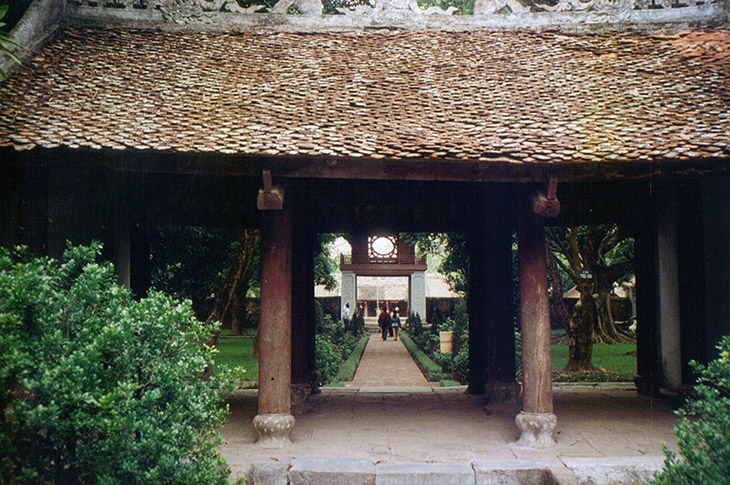
From here we walked to where Ho Chi Minh is lying in his mausoleum, and then to the nearby National Museum. On a scale of boring to fascinating, the museum rated somewhere near the low end of the scale. But, I obliged with interested grunts in all the right places. But when I later learned that local residents are critical of the museum, I didn’t feel too guilty at feeling bored.
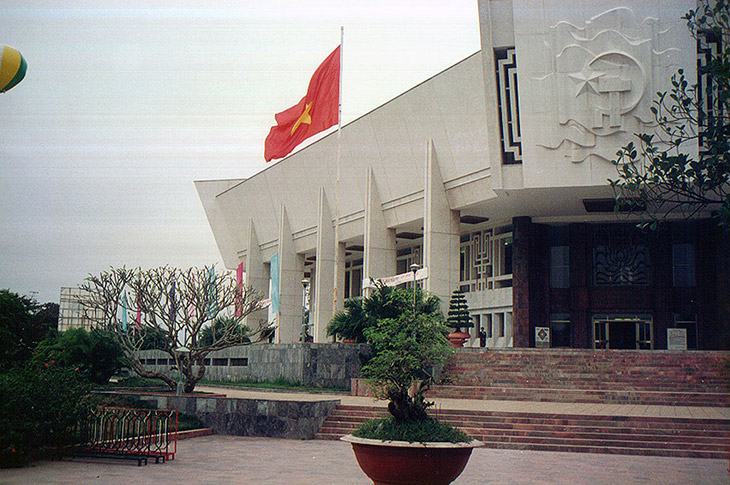
Also during the afternoon, we visited a small garden with lake. In the lake was a tiny temple, constructed on top of a single stone column. I thought this was quite unique, but apparently they are quite common in Vietnam.
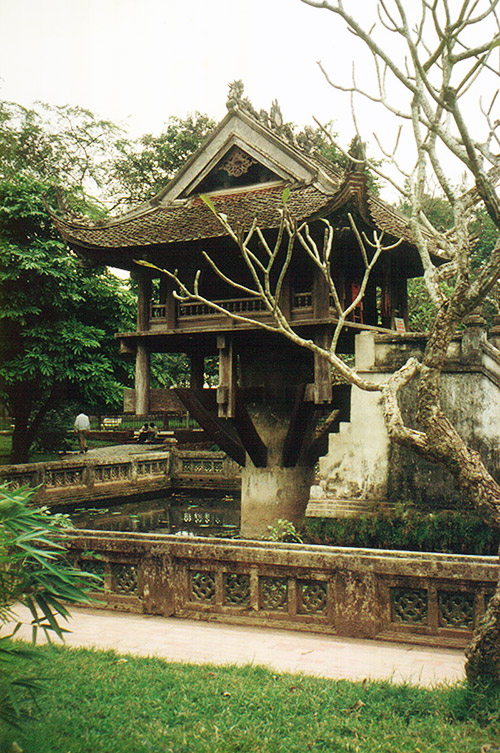
By 4pm we were running short of time because we’d both been invited to the Official Opening of a new IBM showroom. If I’d understood correctly, the driver should have known where we were, and was scheduled to magically reappear. He didn’t.
Taxes are few and far between, and although it’s possible to call for a cab, public phone booths are equally scarce. Almost as rare, but easier to hail, are the three-wheeled pedicabs, or “Cyclos.” And so we found ourselves sitting up front on the not-too-wide wide seat, while the guy behind pedalled his heart out.
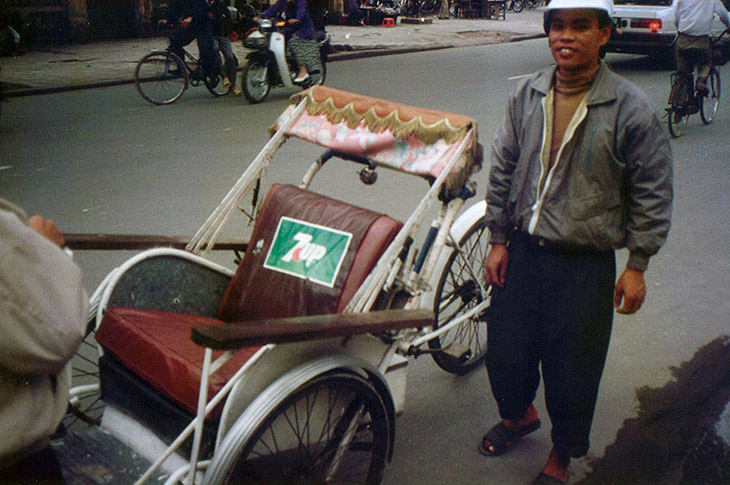
So now I was plowing straight into the traffic without even the protection of a motorcycle rider in from of me. I was just being carried into the thick of the chaos by some unseen means of propulsion. With camera in hand I tried to focus of the sights around me, and clicked away at anything and everything which looked different, and within minutes a whole roll of film had been consumed.
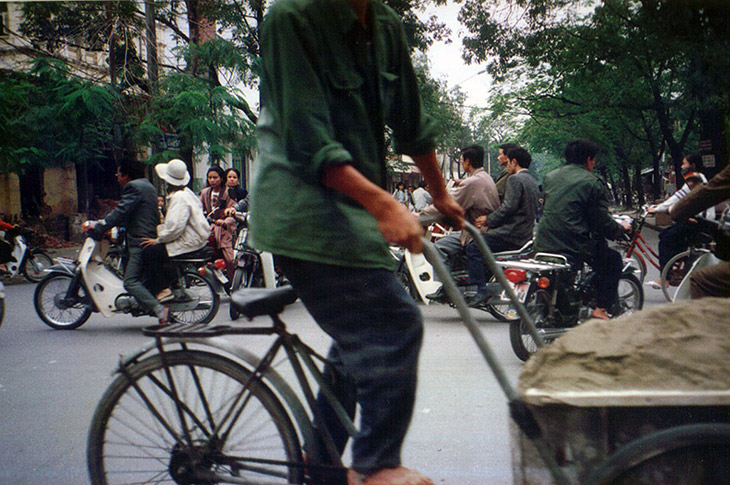
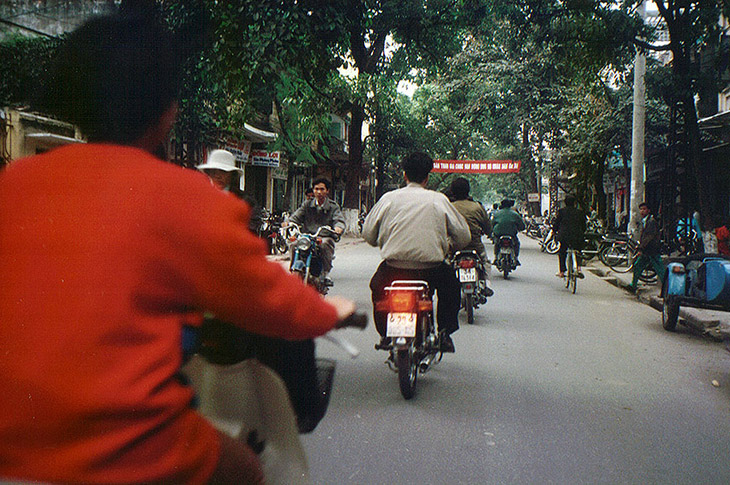
One of the sights I’d noticed during my travels around the city was a whole street of hairdressers – not hairdressing salons – but just a street with a long wall, where the hairdressers hung their mirrors, in front of which they placed their inevitable tiny stools.
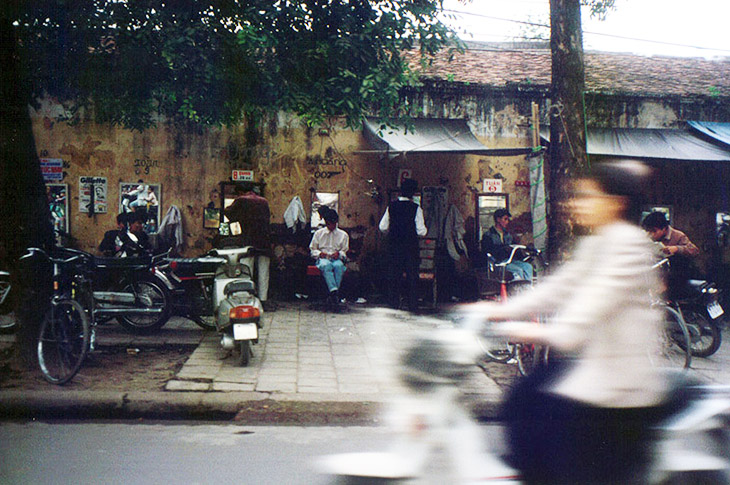
Arriving a little late for the showroom opening, I was ushered into an upstairs room of yet another office building – where the Minister of Science, Technology and the Environment was giving his showroom-opening speech. The room was large enough to hold about fifty people quite comfortably, but there were at least a hundred lining the walls three deep. While in the center of the room there were tables of food, along with bottles of both scotch and champagne. Once the five or six speeches had finished and the Minister had quietly slipped away, it became obvious that the only reason there were so many people present was because they’d come to devour the contents of the bottles. The food was largely untouched.
The Johnnie Walker Black Label was by far the most popular. But, to save consuming too much liquor at such an early hour, I stuck with the rather excellent Russian “Champagne.” With one bottle of scotch being roughly equivalent to the monthly salary of each person in the room, it was easy to see why it was so popular. The glasses were about as tiny as the miniature tea cups I’d encountered every place I’d been, but they were refilled at five second intervals. Within thirty minutes most people were well and truly plastered.
I managed to spend some time talking with the Americans from IBM, comparing notes on Vietnam in general and Hanoi in particular. One guy, who’d been in Hanoi just one day longer than me, had also sat and written pages and pages of notes at the end of his first day. We both agreed the place was so different that it was important to get thoughts onto paper quickly, and as it turned out, neither of us had done this before.
Meanwhile, we were both kind of dragged away to mingle with the locals, who were getting steadily merrier and merrier. I found myself stuck with some guy whose uncle was Managing Director of the company I was visiting, so I really couldn’t be too rude. But with his poor English accent, and general state of inebriation, to say we had a conversation would not be strictly accurate. To every question I asked he answered “yes” – and I’m quite sure if I’d asked “You’re a drunken idiot, aren’t you?” he would have happily agreed. I suspect my answers to his unintelligible questions were no better, but I spent my time concentrating on his glass, which was being waved wildly, while copious quantities of scotch were being spilled down his jacket.
So after about an hour talking with some of the most influential people in the Vietnamese computer industry, I’m quite sure none of them will have any recollection of our meeting. Eventually, I was driven – yes in the company car – back to my hotel, where I finally could relax and get back to note writing. A late visit to Le Bistro – for a rather more plain meal of steak-frites, crème caramel and several glasses of red wine, all for the princely sum of US$6 – rounded out the day.
Day 3 – Less Of The Same
For me, day three began somewhere around 3am. I was suddenly aware the room was quiet, rather stuffy, and very dark. There had been some kind of power failure. The airconditioner was motionless and silent. What little light there had been was now gone, and without any windows in the room, it was difficult to know whether I was dead or alive.
Luckily I’d brought a flashlight, so I could quickly confirm I was alive, and that I wasn’t supposed to be awake. It was about three and half hours before power was restored. The room became quite stuffy and sleeping was difficult.
At breakfast my attention was drawn to a table with a couple of Australian guys. They were noisily and earnestly applying Band Aids to each other’s arms and elbows. It was impossible not to get drawn into their discussion. “Cyclo racing” was about all I could discover when they first caught my eye. Later I learned they had paid two cyclo-rickshaw drivers to sit in the front, while they pedalled. Then they gave many, probably useless, tips on cyclo riding, including the fact they are almost impossible to steer when ridden quickly, and have a habit of tipping over. This apparently explained the grazed elbows.
All of this “fun” had taken place somewhere around 2:30am at the start of a night’s entertainment. No doubt the rest of Hanoi was delighted to hear the Aussies were leaving on a lunchtime flight.
Returning my attention to my own day ahead, I suddenly remembered that somewhere during the evening’s drinking session I’d been persuaded to give a software demonstration to the IT Manager of a major bank. He was, I was told, “the most important person in IT in Vietnam.” At the time I was told this, he looked just like all the IT people in the room – totally hosed. However; a quiet day was in store, so I agreed, and at 8:30am I was escorted from the hotel – this time, on foot.
So, the first decision of the morning was – can we get three people and one whole computer system onto two motorbikes? Thankfully, it was deemed impossible and a taxi was called. After a short ride, during which I could hear the computer monitor rolling around in he trunk, we arrived at a huge building, along with the computer visually undamaged.
The building was apparently constructed to house the Central Bank, but is now the head office of Vietnam’s largest commercial bank. It looked like a cross between London’s St. Paul’s Cathedral and the Royal Albert Hall – both outside, and in. The main banking area was cavernous, with at least 100 wickets and tellers. The inside area of the main floor housed another 200-300 people, all with networked PCs. This bank was certainly well automated, more so than many western banks. Our PC was setup, demos were done, discussions took place, and all this finished at about 2pm, after a suitable break for lunch.
Someone suggested eating at “Le Bistro” so of course I readily agreed. A change would have been nice, but I wasn’t ready for more snails or any other “delicacy” they may think of to test my tolerance to their eating habits. During lunch I was told someone would be giving me a tour of the city later in the afternoon, but the who, how, what and when were kept a secret.
When we arrived back at the office I discovered how these people normally eat their lunch. The rest of the workers had laid out a large mat on the tiled floor, and with shoes off, were sitting cross-legged eating a mixture of rice, vegetables and noodles. Once this was over, and I was sure all the business dealings were completed, I decided to head back to the hotel to change before the guided tour. Business clothes and Buddhist temples don’t really go together. Aside from which, I figured if they weren’t going to give me any more details, then I could safely assume the tour could just as easily begin from the hotel.
Soon after 3pm as I was sitting in reception trying to negotiate the details of my next morning’s early departure, a young lady walked in carrying my business card. I correctly assumed she was the appointed guide. She seemed rather nervous at having been dragged away from her normal daily routine in order to act as a tour guide to some tall, ugly foreigner. And, as I soon discovered, her odd pronunciation of English wasn’t going to make the afternoon any easier. Then I discovered I was supposed to ride on the back of her motorbike.
Although I could see a rear passenger seat, which was certainly going to help keep me in place, I wasn’t too sure how she would react, if – to save myself from being deposited under a Russian tank-like truck – I was to grab some sensitive part of her anatomy. Not that I had any idea which parts of the anatomy the Vietnamese consider sensitive. Hence “Can we walk?” was my now familiar opening question. “Oh yes” she replied, to my relief. However; after half a block she was puffing and panting, and politely asked if we could slow down.
At this point I got a guilty conscience and suggested the motorbike would be just fine. Then things became kind of silly.
We wandered back to the hotel, where she jumped on the bike, muttering something about me staying put while she went off to get some gas. She disappeared. Thirty minutes later she hadn’t returned. This didn’t really matter since it’s darned near impossible to get bored standing on a Hanoi sidewalk. There are many women strolling along with their ubiquitous conical hats – a long wooden yoke across their shoulders, with two huge baskets – from which they sell all manner of goods – mostly fruits and vegetables. They all enquire whether or not you’re buying, and without stopping, accept a quick shake of the head as a negative response.
But the shoe shine boys are a totally different matter. They seem to appear from nowhere at about one minute intervals, and insist that your shoes just have to be polished. You can try “no” in twenty languages and in twenty different tones; you can look angry, bemused or tolerant; you can even ignore them totally, but they won’t go away until they’re totally convinced you are not a potential customer. Anyways, with so much dust and sand in the air, shoeshining seems like a total waste of time, and from an occasional glance downwards, it’s very obvious the locals agree.
Any of the passing “cyclo” drivers will inquire whether you need a ride, and often stop to offer just about any other service you may desire – so they become a source of entertainment. I was in some deep and totally meaningless conversation with a couple of them when my guide magically reappeared – on foot. “Bike broke down, taxi coming soon” was about all I could discover, but I’m sure this was a face-saving gesture in which she’d returned to her office, dumped the motorbike and called a cab. So after about another thirty minutes of watching the traffic for taxi #34 – letting a number of others pass us by – we were underway on our tour.
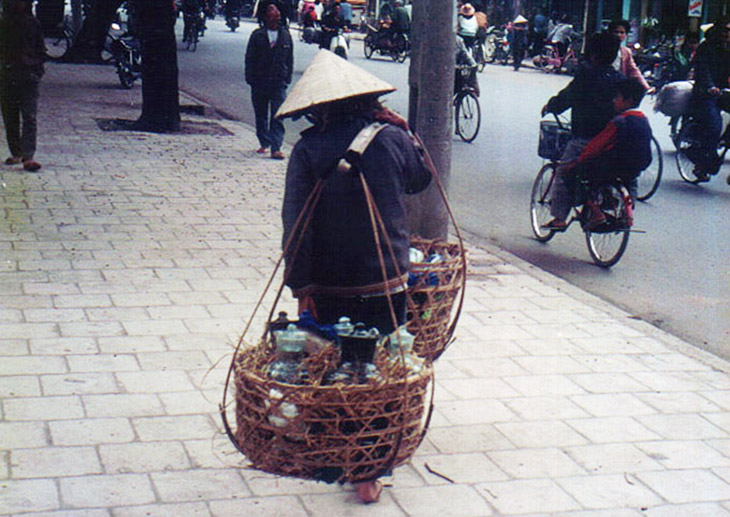
I can’t claim to have seen anything too spectacular, but with the weather continuing overcast and cool, nothing was going to look too inviting. We visited temples, art galleries, and towards the end of the afternoon we drove around one of the large lakes.
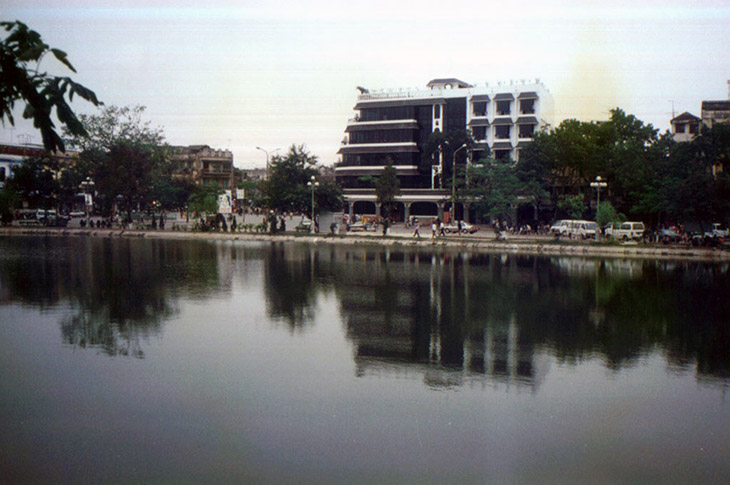
Our last port of call was some kind of antique store filled mostly with large wooden Buddhas. After a little hunting I found a few interesting items – one of which I actually bought. I was told it was a “smoking pipe” but I suspect it was used for opium. And in yet another display of the lack of hygiene my guide showed me how to use the pipe by sticking the well-used mouthpiece into her mouth.
The pipe is about forty centimeters long, and has an ornate outer coating of what looks like silver. It could have been recently manufactured as a “genuine antique” just for tourists, but if so, the “oldness” had been skillfully added. Either way, it was a bargain at just US$10. A lot of the other items were similarly priced, and I could have filled a suitcase, but didn’t.
So, following a short drive from the antique store I was deposited back at my hotel, in time for a final evening at Le Bistro.
By this point in the story, you can assume I ate well. I particularly enjoyed their duck rillettes, which were so good, and so nicely presented in their own china pot with matching lid, that I decided to try to buy some to bring home. I thought that might be a challenge, but I was immediately understood, and moments later a pot appeared, wrapped in a plastic bag. The charge? US$3. I should have bought a dozen.
Back at the hotel I made final arrangements for my early departure by paying the bill, and once again reminding the nice ladies at reception that I needed a taxi at 5:30am. And once again I tried to find some way to order breakfast, but failed.
By 10pm my suitcase was packed, the last beer consumed, and I was ready for an early night.
Day 4 – The Journey Home
At 4:50am the alarm rang, and by 5:30am I was showered, dressed, and had eaten most of an apple from the fruit basket thoughtfully provided in my room. The phone rang to announce the arrival of my taxi, and within a couple of minutes I was on my way back to the airport.
Considering the time of day, there was a surprising amount of traffic on the streets, but most of it was bicycles, and most seemed to be moving goods from one place to another. I had the impression this transfer of commodities had gone on through the night.
At least the taxi driver was not using his horn unless absolutely necessary. At most junctions, or when coming up behind slower moving traffic, he flashed his headlights vigorously.
Once away from the main boulevards, and back into the small rural streets, with what little light was available from the dim street lights, and from the even dimmer headlights of the taxi, it was obvious a fair amount of business was taking place. One street was almost completely blocked by a market, which was being held at ground level. Bicycles laden with baskets were left everywhere, Fruits and vegetables of all kinds were spread around on the road. More bicycles were being wheeled into place, presumably to move the purchased goods. Later in the day this would have created total chaos, but at 5:30am it was just an inconvenience.
A number of cyclists seemed to be very well dressed, and since offices don’t open until 9am, I had to assume the riders were faced with a very long trip to and from their places of employment. How all of these activities can take place in the long monsoon season, when streets are often flooded, I just couldn’t figure. I had the feeling the standard Asian excuse of “I can’t reach the office today because it’s raining” wasn’t going to be accepted in Vietnam.
Once at the airport, the check-in and baggage handling, plus the inevitable payment of airport taxes, were all managed smoothly, and I had time to grab a quick snack. On the first leg of my journey, I was only faced with a domestic flight to Ho Chi Minh City, which even the locals still call Saigon. I was excited about the possibility of seeing the whole length of the country, but a little apprehensive about flying Vietnam Airlines. As it turned out, I had my emotions the wrong way round.
The flight was perfect. The aircraft, an almost new Airbus A310, along with a French flight crew, was very spacious and clean. The Vietnamese cabin crew was very attentive, and a full breakfast was served, so this was a good start to the journey home.
By contrast, with the thick cloud that lasted until a short distance from Saigon, and with a view looking almost directly into the morning sun, I saw just about nothing at ground level. But after a very relaxing two hour flight (Vietnam is a long thin country) we were landing at Saigon International Airport.
From the runway the airport looked remarkably similar to the one at Hanoi. There were signs of military activity, and many old dilapidated buildings. But on the inside of the terminal building, it was obvious there was much more money being spent on Saigon. The terminal had been fully renovated, and looked no different from any modern facility anywhere in the world. The duty free stores – which were run by many different companies, thus creating some unexpected competition in a communist environment, were first class – and very reasonably priced. Not only did they have the usual collection of liquors, wines, smokes, perfumes, etc., but there was a number specializing in the sale of local crafts. Once again, I could have filled a suitcase.
From looking at other tourists though, it seemed like the whole of Vietnam was being exported. In the departure hall there was a special area to get purchases properly prepared for shipment, all for the modest fee of US$3. And the facility was being well used by many travellers. Sheets of cardboard, chunks of polystyrene, and a special banding machine were in constant use. Some people arrived at the airport looking like they’d just bought the interior of a local Buddhist temple.
Although I had a total of four hours to wait in Saigon, I was kept fairly busy with the inevitable paperwork of checking-in, presenting exit visas and baggage declarations, but again this was handled casually. One area was set aside for passengers to identify their baggage, but anyone – like me – who said “mine’s not there” was told “doesn’t matter” and to proceed for boarding. In the time I had to look around the airport, both inside and out, it looked like there was a lot more money being spent on just about everything. The airport was much more luxurious than Hanoi, the vehicles were bigger and better, people were better dressed, and there were far fewer bicycles and motorbikes. Perhaps the weather had a psychological effect. Under clear blue skies the temperature was a pleasant 26°C at 9am. Much nicer than the 15° and drizzle of Hanoi.
Eventually it was time to board the MAS flight back to Kuala Lumpur, which, as it turned out, was probably the worst part of the whole trip. My pre-booked window seat was occupied. There was no space for cabin baggage. The crew seemed unable to cope with a a plane-load of non-English speaking passengers, and even though a few glasses of wine helped, I was glad when it all came to an end.
Conclusions
Suddenly it was all over.
It had seemed like a lifetime, partly because in four days I had experienced more than most people do in a whole lifetime. Without doubt, it was a highly rewarding experience.
I often look at new places – new to me that is – with the idea that I might want to live there some day. With Vietnam, I had to conclude I wouldn’t want to do it anytime soon. One day, maybe. The infrastructure is weak. Hygiene is definitely a problem. As far as I could determine there is no adequate health or school system.
But, things are changing. And if the rate of change can be continued and the present work ethic maintained, there’s no reason to suppose that lives will not improve dramatically.
 To close; I hope you have enjoyed these insights into what was a fascinating trip, one I feel privileged to have been able to undertake, at an important point in Vietnam’s development.
To close; I hope you have enjoyed these insights into what was a fascinating trip, one I feel privileged to have been able to undertake, at an important point in Vietnam’s development.

